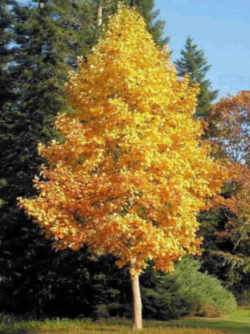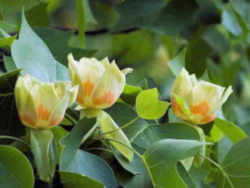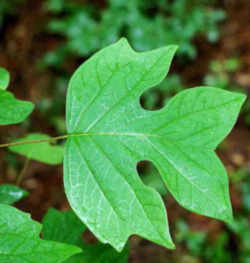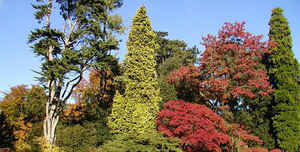Indiana State Tree
Tulip Tree

(Magnoliaceae Liriodendron tulipifera)
Adopted in 1931.
The tulip tree, (Liriodendron tulipifera,) was adopted as the official State tree of Indiana by an act of the State legislature approved on March 3, 1931 It attains great height and can be found throughout the state. The leaf is distinctive (it appears in the border of the state seal), and the lovely bell-shaped greenish-yellow flowers appear in May or June. The soft white wood has many uses.
Designation as the official state tree wasn't the first official recognition given to the tulip tree. The distinctive tulip tree leaf is found in the border of the State Seal of Indiana designed in the 1800s and from 1923 to 1931 the blossom of the tulip tree served as the official floral emblem of Indiana. The tulip tree is the state tree of Indiana, Kentucky, and Tennessee.
Indiana State Tree: Tulip Tree

Liriodendron tulipifera - known as the tulip tree, American tulip tree, tuliptree, tulip poplar, whitewood, fiddle-tree, and yellow poplar - is the Western Hemisphere representative of the two-species genus Liriodendron, and the tallest eastern hardwood. It is native to eastern North America from Southern Ontario and Illinois eastward across southern New England and south to central Florida and Louisiana. It can grow to more than 50 m (165 feet) in virgin cove forests of the Appalachian Mountains, often with no limbs until it reaches 25-30 m (80-100 feet) in height, making it a very valuable timber tree. It is fast-growing, without the common problems of weak wood strength and short lifespan often seen in fast-growing species.
Yellow-poplar (Liriodendron tulipifera) is one of the most attractive and tallest of eastern hardwoods. It is fast growing and may reach 300 years of age on deep, rich, well-drained soils of forest coves and lower mountain slopes. The wood has high commercial value because of its versatility and as a substitute for increasingly scarce softwoods in furniture and framing construction. Yellow-poplar is also valued as a honey tree, a source of wildlife food, and a shade tree for large areas.
Common Names
Yellow-poplar (Liriodendron tulipifera), also called tuliptree, tulip-poplar, white-poplar, and whitewood
Identification of the Tulip Tree

- Leaf: Alternate, simple, palmately veined, orbicular, 4-lobed with an entire margin, 4 to 8 inches long. Somewhat shaped like a tulip.
Flower: Showy, but high in the tree, 2 1/2 inches long, with yellow-green petals and an orange corolla. Present April to June. - Fruit: An oblong aggregate of samaras, deciduous at maturity. Each samara is 1-winged, 1 1/2 inches long, and 4-angled. Maturing August to October.
- Twig: Red-brown in color, often with a shiny appearance or a waxy bloom. Stipules are large and encircle the twig. Buds are elongated and valvate, resembling a "duck bill". Twigs have a sweet, spicy odor when broken.
- Bark: Light gray-green in color, often with white in grooves or in patches. Smooth when young, developing flat-topped ridges and furrows in diamond shaped patterns. On older trees sapsucker holes are common.
- Form: In a stand, this tree is very straight with a limb-free bowl. Open-grown trees have a pyramidal crown when young, becoming oval in shape.
Indiana Law
The law designating the Tulip tree; peony as the official Indiana state tree is found in the Indiana Code, Title 1 (GENERAL PROVISIONS) Article 2 (STATE EMBLEMS) Chapter 8 (STATE BIRD) Section 1-2-7-1.
TITLE 1. GENERAL PROVISIONS.
ARTICLE 2. STATE EMBLEMS.
CHAPTER 7. STATE FLOWER AND TREE.
SECTION IC 1-2-7-1.
IC 1-2-7-1
Tulip tree; peony
Sec. 1. The tulip tree (liriodendron tulipifera) is hereby adopted and designated as the official state tree, and the flower of the peony (Paeonie)
is hereby adopted and designated as the official state flower of the state of Indiana.
(Formerly: Acts 1931, c.48, s.1; Acts 1957, c.283, s.1.)
Taxonomic Hierarchy: Tulip tree
Kingdom: Plantae - Plants
Subkingdom: Tracheobionta - Vascular plants
Superdivision: Spermatophyta - Seed plants
Division: Magnoliophyta - Flowering plants
Class: Magnoliopsida - Dicotyledons
Subclass: Magnoliidae
Order; Magnoliales
Family: Magnoliaceae - Magnolia family
Genus: Liriodendron L. - tuliptree
Species: Liriodendron tulipifera L. - tuliptree








